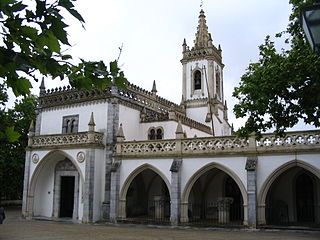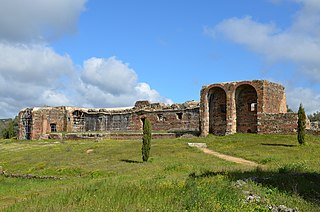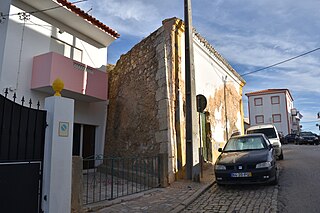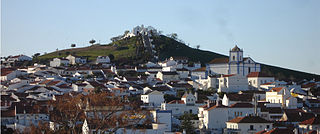
Beja is a city and a municipality in the Alentejo region, Portugal. The population in 2011 was 35,854, in an area of 1,146.44 km2 (442.64 sq mi). The city proper had a population of 21,658 in 2001.

The Castle of Salir is an Almohad fortress, located in the civil parish of the same name, 16 kilometres from the municipality seat of Loulé in the Portuguese Algarve.

Castro Verde is a town and a municipality of the Alentejo region of Portugal. The population in 2011 was 7,276, in an area of 569.44 km2. Castro Verde is situated in the Baixo Alentejo subregion, within a territory known locally as the Campo Branco . The municipality can be recognized by the local municipal markers along its borders, that appear within its borders to denote its reference as A Window on the Plains; municipal markers appear as stylized house profiles, with an exaggerated window that allows the visitor to see through into the panorama.

The Roman ruins of São Cucufate is a Romanesque archaeological site, located on the ruins of a Roman-era agricultural farm in the civil parish of Vila de Frades, in the municipality of Vidigueira, in the southern Alentejo, Portugal. The convent, which dates back to Middle Ages, was dedicated to the martyred saint Cucuphas.
The Prehistoric Rock-Art Site of Escoural Cave is a structure known for its Paleolithic-era rock-art and funerary burial site, located in the Portuguese municipality of Montemor-o-Novo, in the civil parish of Santiago do Escoural.

The Castle of Viana do Alentejo is a gothic castle constructed during the reconquest and settlement of the central region of the Portuguese Alentejo, located in the parish of Viana do Alentejo, municipality of the same name. Although a relatively low-profile design, in comparison to its contemporaries, the structure served the period of strife associated with expansion of Portuguese forces/authority into the southern Algarve.

The Castle of Alcantarilha is a medieval fortress and its remnant walls in Portugal, in the civil parish of Alcantarilha, municipality of Silves, in the Portuguese Algarve region of southwestern Iberia. It is a little-known monument, now in ruins, used for the protection of the people of the village and surrounding area from attacks by north African pirates.

The Castle of Beja is a medieval castle in the civil parish of Beja, municipality of Beja, Portuguese district of Beja.

The Castle of Aljustrel is a Portuguese medieval castle in civil parish of Aljustrel e Rio de Moinhos, in the municipality of Aljustrel, in the district of Beja.

Torrão is a civil parish and town, in the municipality of Alcácer do Sal, in the Portuguese district of Setúbal, bordering on the districts of Évora and the Beja. It is crossed by the river Xarrama River. The population in 2011 was 2,295, in an area of 372.39 km2.

The Archaeological site of Cabeço do Vouga, also known as Castelium Marnelis, is an archaeological site in civil parish union of Trofa, Segadães e Lamas do Vouga, in the municipality of Águeda, in central Portugal. It is classified as a Property of Public Interest, and dates back to the Iron Age.

The Castle of Moura is a Portuguese medieval castle in civil parish of Moura e Santo Amador, in the municipality of Moura, in the district of Beja.

The Castle of Portel is a medieval castle located in the municipality of Portel in the district of Evora in Portugal.

The Castle of Noudar is a Portuguese medieval castle in the civil parish and municipality of Barrancos, in the district of Beja.
The Castro of Castelo Velho is a Chalcolithic settlement in the civil parish of Terena, municipality of Alandroal in the Alentejo Central area of the Portuguese Alentejo.

The Roman villa of Freiria is a Roman villa in the civil parish of São Domingos de Rana, in the Portuguese municipality of Cascais.

The Roman Ruins of Pisões, is an important Roman villa rustica located in the civil parish of Beja in the municipality of Beja, in the Portuguese Alentejo, classified as a Imóvel de Interesse Público.

The Castro of Chibanes is located in the Arrábida Nature Park, on the Serra do Louro, in the municipality of Palmela in the Setúbal District of Portugal, about 25 km (16 mi) south of the capital of Lisbon, which can be seen from the site. The Castro, or hill fort, is located at the top of the hill, naturally defended by a scarp to the south. It covers about one hectare and was first occupied in about 2900 BCE, during the Chalcolithic or Copper Age. It is registered as a Zona Especial de Protecção and also classified as a Sitio de Interesse Público.




















